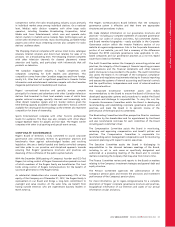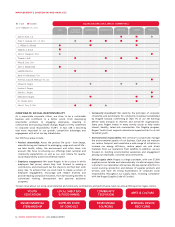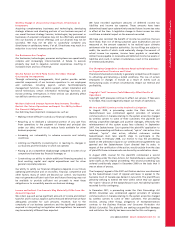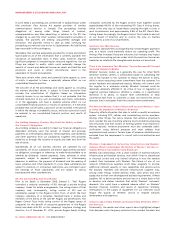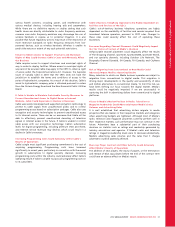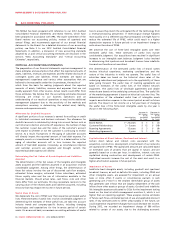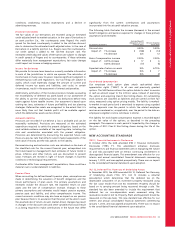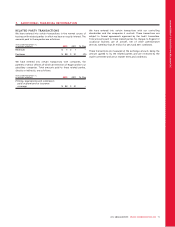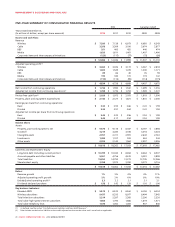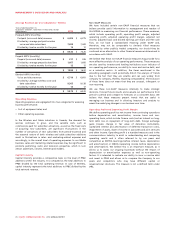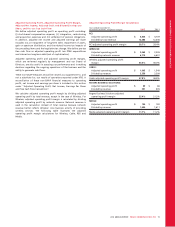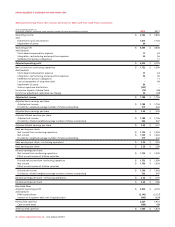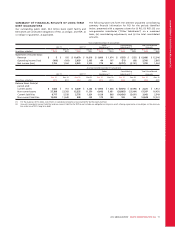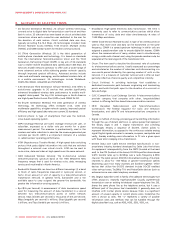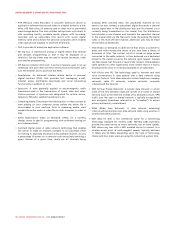Rogers 2012 Annual Report Download - page 74
Download and view the complete annual report
Please find page 74 of the 2012 Rogers annual report below. You can navigate through the pages in the report by either clicking on the pages listed below, or by using the keyword search tool below to find specific information within the annual report.MANAGEMENT’S DISCUSSION AND ANALYSIS
IAS 1, Presentation of Financial Statements
In June 2011, the IASB amended IAS 1, Presentation of Financial
Statements (“IAS 1”). This amendment requires an entity to separately
present the items of OCI as items that may or may not be reclassified
to profit and loss. This classification has been presented on the
Statements of Other Comprehensive Income for the years ended
December 31, 2012 and 2011.
RECENT ACCOUNTING PRONOUNCEMENTS
IFRS 10, Consolidated Financial Statements
In May 2011, the IASB issued IFRS 10, Consolidated Financial
Statements (“IFRS 10”). IFRS 10, which replaces the consolidation
requirements of SIC-12 Consolidation-Special Purpose Entities and
IAS 27 Consolidated and Separate Financial Statements, establishes
principles for the presentation and preparation of consolidated
financial statements when an entity controls one or more other
entities. This new standard is effective for our interim and annual
consolidated financial statements commencing January 1, 2013. We
are assessing the impact of this new standard on our consolidated
financial statements.
IFRS 11, Joint Arrangements
In May 2011, the IASB issued IFRS 11, Joint Arrangements (“IFRS 11”).
IFRS 11, which replaces the guidance in IAS 31, Interests in Joint
Ventures, provides for a more realistic reflection of joint
arrangements by focusing on the rights and obligations of the
arrangement rather than its legal form (as is currently the case). The
standard addresses inconsistencies in the reporting of joint
arrangements by requiring interests in jointly controlled entities to be
accounted for under the equity method. This new standard is
effective for our interim and annual consolidated financial statements
commencing January 1, 2013. We are assessing the impact of this new
standard on our consolidated financial statements.
IFRS 12, Disclosure of Interests in Other Entities
In May 2011, the IASB issued IFRS 12, Disclosure of Interests in Other
Entities (“IFRS 12”). IFRS 12 establishes new and comprehensive
disclosure requirements for all forms of interests in other entities,
including subsidiaries, joint arrangements, associates and
unconsolidated structured entities. This new standard is effective for
our interim and annual consolidated financial statements
commencing January 1, 2013. We are assessing the impact of this new
standard on our consolidated financial statements.
IFRS 13, Fair Value Measurement
In May 2011, the IASB issued IFRS 13, Fair Value Measurement
(“IFRS 13”). IFRS 13 replaces the fair value guidance contained in
individual IFRS with a single source of fair value measurement
guidance. The standard also requires disclosures that enable users to
assess the methods and inputs used to develop fair value
measurements. This new standard is effective for our interim and
annual consolidated financial statements commencing January 1,
2013. We are assessing the impact of this new standard on our
consolidated financial statements.
IAS 19, Employee Benefits
In June 2011, the IASB amended IAS 19, Employee Benefits (“IAS 19”).
This amendment eliminates the concept of return on plan assets and
interest cost and replaces them with a net interest cost that is
calculated by multiplying the discount rate by the net liability (asset).
The amendment also eliminates the use of the “corridor” approach
and mandates all re-measurement impacts be recognized in OCI. It
also enhances the disclosure requirements, providing better
information about the characteristics of defined benefit plans and the
risk that entities are exposed to through participation in those plans.
The adoption of the amended standard will result in an increase in
pension expense of $7 million for the year ended December 31, 2012
upon retrospective application when the amended standard is
adopted beginning January 1, 2013.
IAS 27, Separate Financial Statements
In May 2011, the IASB amended IAS 27, Separate Financial Statements
(“IAS 27”). This amendment removes the requirements for
consolidated statements from IAS 27 and moves it over to IFRS 10,
Consolidated Financial Statements. The amendment mandates that
when a company prepares separate financial statements, investment
in subsidiaries, associates and jointly controlled entities are to be
accounted for either using the cost method or in accordance with
IFRS 9, Financial Instruments. In addition, this amendment determines
the treatment for recognizing dividends, the treatment of certain
group reorganizations and some disclosure requirements. This
amendment is effective for our interim and annual consolidated
financial statements commencing January 1, 2013. We are assessing
the impact of this amended standard on our consolidated financial
statements.
IAS 28, Investments in Associates and Joint Ventures
In May 2011, the IASB amended IAS 28, Investments in Associates and
Joint Ventures (“IAS 28”). This amendment requires any retained
portion of an investment in an associate or joint venture that has not
been classified as held for sale to be measured using the equity
method until disposal. After disposal, if the retained interest
continues to be an associate or joint venture, the amendment
requires it to continue to be accounted for under the equity method.
The amendment also disallows the re-measurement of any retained
interest in an investment upon the cessation of significant influence
or joint control. This amended standard is effective for our interim
and annual consolidated financial statements commencing January 1,
2013. We are assessing the impact of this amended standard on our
consolidated financial statements.
IFRS 9, Financial Instruments
In October 2010, the IASB issued IFRS 9, Financial Instruments
(“IFRS 9”). IFRS 9, which replaces IAS 39, Financial Instruments:
Recognition and Measurement, establishes principles for the financial
reporting of financial assets and financial liabilities that will present
relevant and useful information to users of financial statements for
their assessment of the amounts, timing and uncertainty of an entity’s
future cash flows. This new standard is effective for our interim and
annual consolidated financial statements commencing January 1,
2015. We are assessing the impact of this new standard on our
consolidated financial statements.
70 ROGERS COMMUNICATIONS INC. 2012 ANNUAL REPORT



